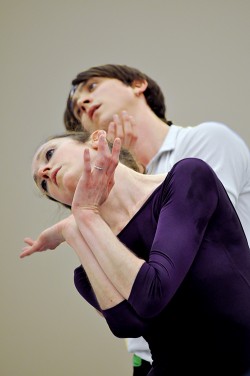Lucas Threefoot started training at the Oregon Ballet Theater when he was four or five. He’s now a 23-year-old soloist with the company.
The lost dance
Lucas Threefoot started training at the Oregon Ballet Theater when he was four or five. He’s now a 23-year-old soloist with the company.

Brian Simcoe started dancing when he was ten. He’s been dancing with the OBT for seven years now.
Both will be performing solo in all four pieces of the OBT’s upcoming performance, Chromatic Quartet. The show premieres tonight at the Newmark Theatre and will run through Saturday, April 28.
“It’s kind of a whirlwind, mentally,” Simcoe said.
The lineup will begin with Igor Stravinsky’s “Violin Concerto in D Major” (1930), for which George Balachine choreographed a ballet in 1972. This piece of music begins with a lively staccato and closes with the muscular and vigorous capriccio that, like much of the symphonic music of the early 20th century, evokes urban excitement and progressive sophistication.
Threefoot said that, though the Stravinsky piece is perhaps the most classically orthodox dance of the bill, “the beauty of Balachine is that he could break out of the boundaries of classical ballet.”
From there, the boundaries of what we laity might recognize as ballet become increasingly distorted.
Take, for example, the “Lambarena,” the final dance on the bill. It was written in honor musician Albert Schweitzer, Nobel Peace Prize recipient and medical missionary to what is now Gabon. The score is a surreal combination of the music of Johann Sebastian Bach and traditional African percussion. The accompanying dance displays the grace and fluidity of the 17th and 18th century French court tradition. But it has a rhythmic punctuation that one typically associates with the traditional music of sub-Saharan Africa.
But the raison d’être of the roster will be the second piece of the evening, for it will be the world premiere of “The Lost Dance,” commissioned by the OBT from Canadian choreographer Matjash Mrozewski.
Mrozewski’s work has been described as “surreal,” “gritty” and “risky.” In rehearsal ,“The Lost Dance” appears to have the exacting, full-body engagement of ballet, with movements that verge on the theatrical. The music was written by Owen Belton, whom Mrozewski has worked with several times.
“What Mat’s done is basically created his own vocabulary for the piece,” Threefoot said. “I wouldn’t call ‘The Lost Dance’ ballet,” he adds.
When asked for the story behind “The Lost Dance,” Artistic Director Anne Mueller said, “It’s an abstract work. There is definitely a scenario that the choreographer had in mind in creating it, but I’m unsure of how much of that he wants to reveal.”
But the buzz in the studio, mentioned by three different company members and confirmed by none, was that it’s a ghost story.
In anticipation of the work on the OBT blog, Matjash commented that, “There might be something ghostly about the piece, atmospheric. If at all possible, I want the ballet to be ghostly, sexy, mysterious, earthy, pedestrian, graceful and, if I’m on a roll, even a bit witty.”
Matjash’s methodology was described by Threefoot and Simcoe as rooted in tradition but dynamic and spontaneous.
“He’ll pick up certain gestures that he’ll see people do, and he’ll use them,” Simcoe said. “We might do the same gesture three different times, in very different contexts.”
Still, the dancers say that, to them, this bill isn’t particularly modern or nontraditional.
“I don’t think this program is super contemporary because it employs the classical technique,” Simcoe said.
By this he means that, though the movements may often look different from classical ballet, they can be described with the same vocabulary since they are mostly derived from the same movements that make up traditional ballet.
Threefoot likens the difference between classical ballet and contemporary ballet to the difference between jazz and classical music. Jazz is no less studied, no less a fine art, but gives more over to the performer’s interpretation. Of course, the word “interpretation” is much more finely parsed when speaking of exactingly choreographed dance than a free-form jam session.
The origin of the name, Chromatic Quartet, and the common thread binding the various works on the bill together posed a quandary to everyone in the studio.
“I would say ‘quartet’ because there are four different works on the program, and ‘chromatic’ because, whether you are going with a musical or color-oriented definition, the word describes the tremendous diversity of the works on this program,” Mueller said.
He also suggested that ballet-goers purview the program notes and familiarize themselves with the music to aid in their appreciation of the pieces.
“There’s a really wide range of movement, and there’s also a really wide range of emotion. I’d say there’s something in it for everyone, whether you know dance or not. In these four dances, there has to be something that will catch your eye,” Treefoot said. “That’s basically why we are dancers: Because we want to make people feel something.”
Chromatic Quartet
April 19, 20, 21, 22, 25, 27 and 28 at 7:30 p.m.
April 21, 22 and 28 at 2 p.m.
Newmark Theatre
1111 SW Broadway Avenue.
$23-$140 at the window
10 percent discount for students with ID.
Tickets available at Ticketmaster with a handling fee






